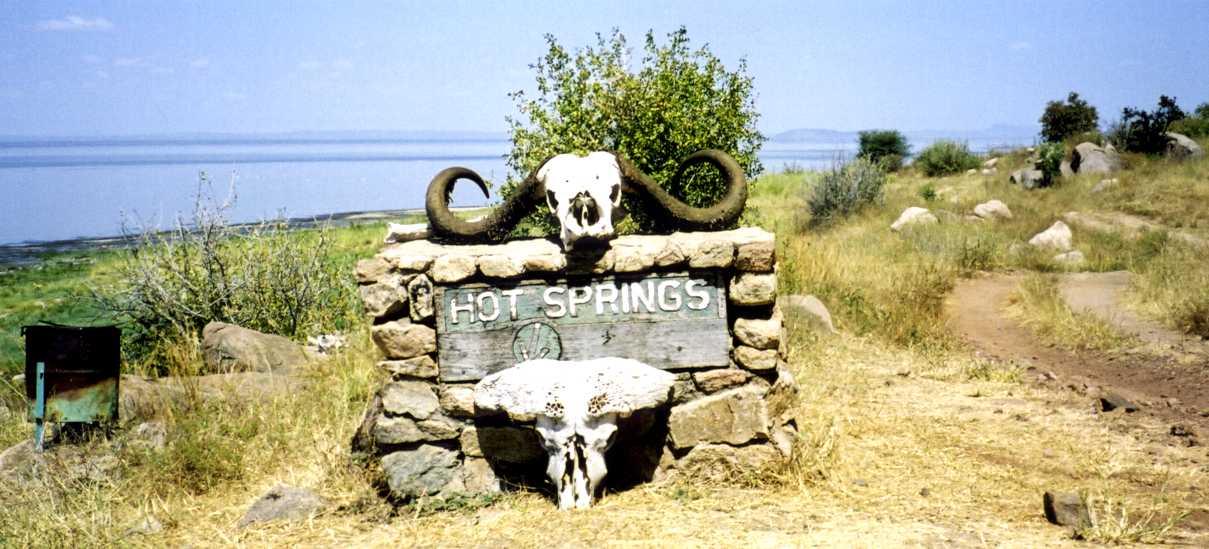
Wednesday, July 17 and Thursday, July 18
Mto wa Mbu, Tanzania:
Twiga Guesthouse and Campsite
We have one more game park to go -- Lake Manyara National Park -- and then we'll have two cultural tourism days at local villages. On our way back from the Serengeti, we stop for lunch at the Olduvai Gorge, a fascinating and important archeological site. This is where the Leakeys found the bones of the earliest hominids.
 We'll spend the next two nights camping at the Twiga
Guesthouse in Mto wa Mbu, a village whose name translates to "River of
Mosquitoes." Luckily, the name does not prove to be particularly accurate.
Staying here is a nice change; we have access to showers, laundry facilities,
and a restaurant and bar. In the evening, the guesthouse puts on a very
touristy show of local dancing followed by an acrobatic show. It's good
entertainment, but doesn't feel very authentic.
We'll spend the next two nights camping at the Twiga
Guesthouse in Mto wa Mbu, a village whose name translates to "River of
Mosquitoes." Luckily, the name does not prove to be particularly accurate.
Staying here is a nice change; we have access to showers, laundry facilities,
and a restaurant and bar. In the evening, the guesthouse puts on a very
touristy show of local dancing followed by an acrobatic show. It's good
entertainment, but doesn't feel very authentic.
We spend Thursday on an all day game drive a Lake Manyara National Park, a small park known for its baboons and elephants, and its large soda lake and hot springs. We stop at the park entrance for the usual paperwork and payment and decide to visit the park's museum. The museum is one room with a number of glass display cases filled with a variety of dead, stuffed animals, mostly rats and other rodent-like animals. We're not very impressed.
Once we get going, though, we are very impressed. We see some huge troops of baboons, some of them standing in the road, very menacing-looking. Some stare at us intently, others ignore us completely, carrying on grooming each other or looking for food. We also see a couple of large males fighting with each other and can hear them screaming and howling for quite some distance.

As we get further into the park, we are able to see a lot of
elephants. Franclin, one of our guides, is studying wildlife
management at university in Kenya; he specializes in elephants and has
participated in a number of elephant rescues and moves. He's as
thrilled as we are to see so many elephants, and is a tremendous source of
information about their lives and their habits. We're even able to see
a couple of baby elephants in the bushes; they're shier than the grown
ones, so they hang back a little, but we're still able to get a pretty good
look.
We stop for lunch by the soda lake, which is the source of the hot springs in the area. Today might be the hottest day that we've had so far; I soak a bandana and sit with it on my head, trying to keep my head from frying. The park is also supposed to be home to a number of tree-climbing lions. We drive around all afternoon, but did not see one.
Today is Randy's 43rd birthday, and we have another tasty cake from the dutch oven. He stays up to celebrate with some of the guys, while I crawl into the tent with another case of sunstroke. (While I'm normally fairly sun-sensitive, I've been taking Doxycycline as an anti-malarial, and it has made my skin incredibly photosensitive, to the point that I can't go out at all without a hat, long pants, and a shirt with sleeves long enough to cover my hands.)

Click here to see more photos from Lake Manyara.
Friday, lucky for me, is overcast, and we go with a local guide from the cultural tourism program for a visit to the village. The village is a good introduction to Tanzanian life because its inhabitants include members of many different tribes. Throughout our travels in Tanzania, a number of different people have told us how the approximately 120 different tribes in Tanzania live harmoniously due, in large part, to the efforts of Tanzania's first president, Julius Nyerere, and his institution of Swahili as a national, unifying language. The people that we've talked to are very proud of the fact that while Tanzanians are proud of their tribal heritage, the country has not had a history of internal conflict or tribal warfare like so many African nations have.
We start our tour. Our first stop is to see some farm land and learn about local crop production methods. Next we stop to see some Makonde carvers. Then we get a little show from the local medicine man, who shows us a variety of herbal remedies, including an herbal version of Viagra. We see a local Chagga woman brewing banana beer, and we take a taste. Here there are no cries of "mzungu" as we pass through town: the people here are quite used to seeing foreigners traipsing through their village.
We stop for a visit at an elementary school, and the children sing Frère Jacques in Swahili for us. We introduce ourselves, and the children ask us questions about where we're from and how we're enjoying our visit to Tanzania. Some people in our group have brought gifts for the children including markers, stickers, and pens, and the teacher takes them and tells us that she'll use them to reward the better students.

Click here to see more photos from Mto Wa Mbu.
We then walk through the banana groves and up to Balaa Hill, known as the hill of miseries because of all of the terrible things that had happened there. There's a massive tree at the top of the hill, and we take a rest there, admiring the view of the village.